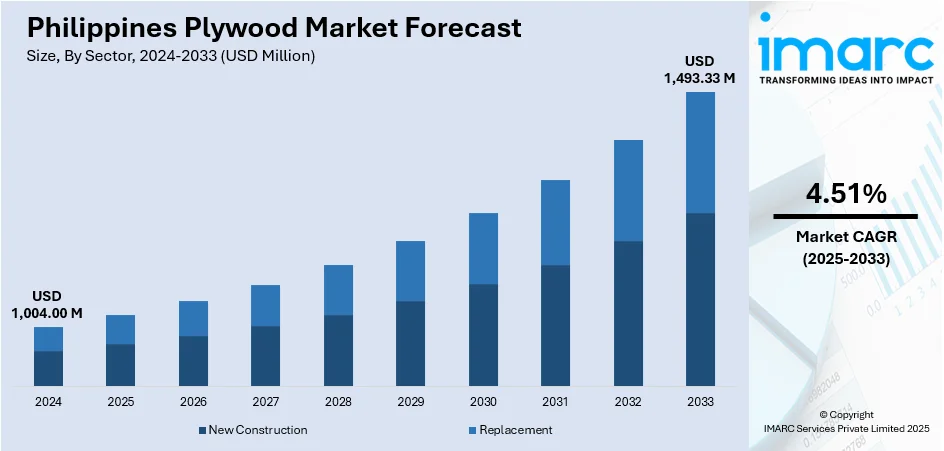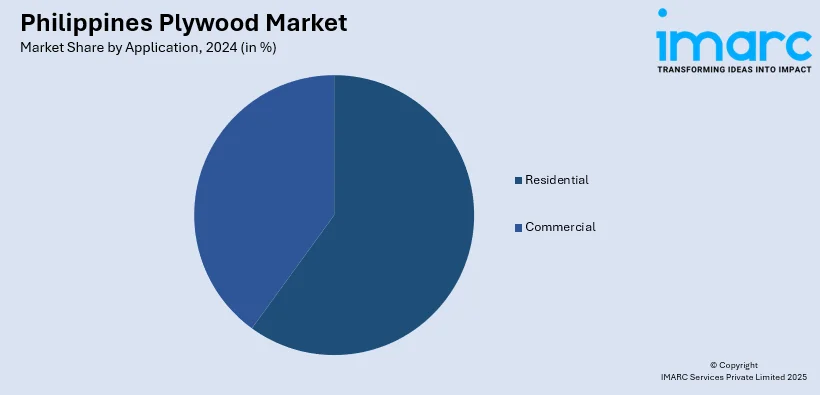
Philippines Plywood Market Size, Share, Trends and Forecast by Application, Sector, and Region, 2025-2033
Philippines Plywood Market Size and Share:
The Philippines plywood market size reached USD 1,004.00 Million in 2024. The market is projected to reach USD 1,493.33 Million by 2033, exhibiting a growth rate (CAGR) of 4.51% during 2025-2033. The broadening of retail channels is catalyzing the demand for cost-effective and versatile materials used in store construction, interiors, and displays. In addition, as new tourist destinations are being developed and existing ones are expanding, there is an increasing need for plywood in furniture, flooring, wall panels, and decorative elements, which is fueling the Philippines plywood market share.
|
Report Attribute
|
Key Statistics
|
|---|---|
|
Base Year
|
2024
|
|
Forecast Years
|
2025-2033
|
|
Historical Years
|
2019-2024
|
| Market Size in 2024 | USD 1,004.00 Million |
| Market Forecast in 2033 | USD 1,493.33 Million |
| Market Growth Rate 2025-2033 | 4.51% |
Philippines Plywood Market Trends:
Rising furniture manufacturing
The growth of furniture manufacturing is positively influencing the market. According to the IMARC Group, the Philippines furniture market size reached USD 4.06 Billion in 2024. With the local furniture sector expanding to satisfy increasing domestic and export demands, plywood is gaining popularity as a material because of its cost-effectiveness, durability, and user-friendliness. Producers are using plywood in numerous furniture items, including cabinets, tables, beds, chairs, and shelving, as it offers strong support and a polished surface ideal for finishing. Plywood is perfect for crafting modular and space-efficient furniture, which is gaining traction in city living spaces, workplaces, and apartments. Small and medium-sized enterprises (SMEs) depend significantly on plywood due to its accessibility, transportability, and ease of processing. Additionally, user preferences are shifting towards modern, minimalist, and cost-effective designs, plywood is offering the flexibility to meet evolving trends. Export-oriented furniture makers also choose plywood to maintain quality while keeping production costs competitive. The ability to laminate, veneer, or paint plywood adds to its appeal in creating attractive and customized furniture. As furniture demand is growing across residential, commercial, and hospitality sectors, plywood remains a key input material, supporting the continuous expansion and resilience of the market.

To get more information on this market, Request Sample
Broadening of retail outlets
The expansion of retail channels is impelling the Philippines plywood market growth. As more shopping malls, supermarkets, convenience stores, and specialty shops are opening across urban and suburban areas, plywood is becoming essential in building shelves, counters, partitions, and decorative fixtures. Retailers prefer plywood because it is durable, lightweight, easy to install, and can be customized to suit different design needs. With rising user spending and retail brands broadening their presence, especially in developing cities, the need for plywood-based interiors and furniture is increasing. The use of plywood in pop-up shops, kiosks, and promotional booths is adding further support to the market growth. Overall, the expanding retail landscape in the Philippines is strengthening the plywood industry through continuous construction and refurbishment needs. As per industry reports, the Philippines retail market is projected to grow at a CAGR of 7.70% during 2025-2033.
Growing tourism activities
Increasing tourism activities are offering a favorable market outlook. According to the information provided on the official website of the Philippine Statistics Authority, in 2024, tourism accounted for 8.9% of the Philippine economy. As new tourist destinations are developing and existing ones are expanding, there is a growing need for plywood in building accommodations, furniture, flooring, wall panels, and decorative elements. Plywood is favored for its affordability, ease of installation, and design flexibility, making it ideal for both permanent and temporary tourist facilities. Small resorts and local businesses often choose plywood to build guest cottages, dining areas, and event spaces due to its cost-effectiveness. Additionally, tourism growth is leading to more investments in transportation terminals and recreational infrastructure, driving plywood demand. With tourism being a vital part of the national economy, continuous expansion in this sector helps sustain and broaden the plywood market across various islands and regions in the Philippines.
Philippines Plywood Market Segmentation:
IMARC Group provides an analysis of the key trends in each segment of the market, along with forecasts at the country and regional levels for 2025-2033. Our report has categorized the market based on application and sector.
Application Insights:

- Residential
- Commercial
The report has provided a detailed breakup and analysis of the market based on the application. This includes residential and commercial.
Sector Insights:
- New Construction
- Replacement
A detailed breakup and analysis of the market based on the sector have also been provided in the report. This includes new construction and replacement.
Regional Insights:
- Luzon
- Visayas
- Mindanao
The report has also provided a comprehensive analysis of all the major regional markets, which include Luzon, Visayas, and Mindanao.
Competitive Landscape:
The market research report has also provided a comprehensive analysis of the competitive landscape. Competitive analysis such as market structure, key player positioning, top winning strategies, competitive dashboard, and company evaluation quadrant has been covered in the report. Also, detailed profiles of all major companies have been provided.
Philippines Plywood Market Report Coverage:
| Report Features | Details |
|---|---|
| Base Year of the Analysis | 2024 |
| Historical Period | 2019-2024 |
| Forecast Period | 2025-2033 |
| Units | Million USD |
| Scope of the Report |
Exploration of Historical Trends and Market Outlook, Industry Catalysts and Challenges, Segment-Wise Historical and Future Market Assessment:
|
| Applications Covered | Residential, Commercial |
| Sectors Covered | New Construction, Replacement |
| Regions Covered | Luzon, Visayas, Mindanao |
| Customization Scope | 10% Free Customization |
| Post-Sale Analyst Support | 10-12 Weeks |
| Delivery Format | PDF and Excel through Email (We can also provide the editable version of the report in PPT/Word format on special request) |
Key Questions Answered in This Report:
- How has the Philippines plywood market performed so far and how will it perform in the coming years?
- What is the breakup of the Philippines plywood market on the basis of application?
- What is the breakup of the Philippines plywood market on the basis of sector?
- What is the breakup of the Philippines plywood market on the basis of region?
- What are the various stages in the value chain of the Philippines plywood market?
- What are the key driving factors and challenges in the Philippines plywood market?
- What is the structure of the Philippines plywood market and who are the key players?
- What is the degree of competition in the Philippines plywood market?
Key Benefits for Stakeholders:
- IMARC’s industry report offers a comprehensive quantitative analysis of various market segments, historical and current market trends, market forecasts, and dynamics of the Philippines plywood market from 2019-2033.
- The research report provides the latest information on the market drivers, challenges, and opportunities in the Philippines plywood market.
- Porter's five forces analysis assist stakeholders in assessing the impact of new entrants, competitive rivalry, supplier power, buyer power, and the threat of substitution. It helps stakeholders to analyze the level of competition within the Philippines plywood industry and its attractiveness.
- Competitive landscape allows stakeholders to understand their competitive environment and provides an insight into the current positions of key players in the market.
Need more help?
- Speak to our experienced analysts for insights on the current market scenarios.
- Include additional segments and countries to customize the report as per your requirement.
- Gain an unparalleled competitive advantage in your domain by understanding how to utilize the report and positively impacting your operations and revenue.
- For further assistance, please connect with our analysts.
 Request Customization
Request Customization
 Speak to an Analyst
Speak to an Analyst
 Request Brochure
Request Brochure
 Inquire Before Buying
Inquire Before Buying




.webp)




.webp)












